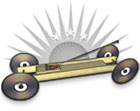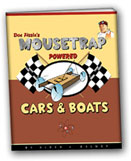Mousetrap Cars: Rotational Inertia
Rotational inertia effect both the travel distance and the acceleration of a mousetrap racer. You cannot build a winning mousetrap racer until you know the basics.
Rotational inertia is the resistance an object has to changes in it's state of rotation. For an object that is not rotating we commonly talk about its inertia or its mass; the more mass an object has, the more resistance the object will have to any change in it's state of motion. With rotational inertia we still talk about an objects mass but we also include the location of it's mass with respect to it's point of rotation. The greater the distance between the average mass of a rotating object and it's point of rotation means the greater the rotational inertia of the object (large wheels have more rotational inertia then smaller wheels of same mass). The more rotational inertia an object has the more torque that will be required to change the objects state of rotation. A large amount of rotational inertia can have an advantage once an object is rotating because it will be harder to stop rotating. Having a wheel with a lot of rotational inertia can be a big advantage when building a long distance traveling mousetrap powered vehicle; but having a wheel with a large amount of rotational inertia is a disadvantage when building a speed-trap dragster.
Mousetrap Racers for Top-Speed
If you are building a super-fast speed-trap racer then rotational inertial is one of the most important concepts you will need to understand. The secret to winning any top-speed mouse trap contest is to get to the finish line in less time than everyone else; what this really means is that you will need to have a greater acceleration from the start line than the rest of the competition. Because most top-speed contest are performed over a set distance friction is not as big of an issue as it would be in a maximum trave distance contest. In a top-speed contest inertia is the biggest problem a mousetrap racer will have to over come in order to be successful; and for this reason, wheels must be carefully selected to have as little rotational inertia as possible. The first tip to remember is that large diameter wheels (more than 4 inches) will have way to much rotational inertia and must be avoided at all cost; try to limit the size of a drive wheels on a speed-trap racer to no larger than 3 inches (depending on the travel distance). Non-drive wheels should be as small and as light as possible. One more important concept to think about when selecting wheels for your speed-trap racer is traction. Since the drive wheel(s) will need to accelerate the racer as fast as possible the wheel will need to be able to grab the road surface without slipping in order to rocket the mousetrap racer to the finish. Sometimes a wheel's traction can be increased by adding traction treads cut from the center of a rubber balloon (see adding traction treads for more information). Before you build your speed-trap mousetrap racer study the design of a top fuel dragsters; their rear drive wheels are designed for maximum traction and their super small lightweight front wheels have almost no rotational inertia. Try to copy the design of a top fuel dragster when building a super-fast speed-trap racer.
bonus tip: use lightweight drive wheels no larger than 3 inches and small front wheels on any speed trap racer in order to decrease the rotational inertia.
Long-Distance Mousetrap Vehicles
How does rotational inertia play into the design of a good distance-traveling mousetrap car? When building a mousetrap car for distance the goal is to convert as much of the mouse trap's starting energy into displace of the vehicle over the greatest linear distance. The starting potential energy of the mousetrap will be needed to overcome the force of friction acting against the vehicle's travel. A mousetrap car cannot move anywhere until the potential energy of the mouse trap's spring puts energy into the wheels and changes their state of rotation from rest into motion; the more rotational inertia a vehicle has the more energy that will be consumed just to get the wheels turning. Use wheels that have as little rotational inertia as possible. If necessary, cut and remove mass from the wheels in order to decrease the rotational inertia.
There have been many mousetrap vehicle builders that have applied the concept of rotational inertial differently over the years. Some have designed and built mousetrap vehicles that have a large and heavy wheel called a flywheel (sometimes made from an old record album) that is designed to store the energy from the mousetrap. The basic concept is that the mousetrap's energy will be converted into the rotational energy of the flywheel and then the flywheel's rotational inertia will keep the vehicle moving with an extended costing distance. I have seen this work but there are some serious flaws in the application of the physics. In a perfect universe the flywheel concept would always win if we were displacing only the wheel. But we are not in a perfect universe and we not just displacing the wheel; instead, we are displace the whole car including the mousetrap. In our real world environment we have to deal with a small but important concept called friction. A mouse trap vehicle will travel further and be more efficient the slower it moves. In fact, the perfect long distance mousetrap vehicle would use energy at the exact same rate as the energy being lost to friction (this means slow moving). A flywheel will require more torque to get it rotating and this will increases the rate at which energy is consumed; the flywheel mousetrap powered vehicle will now have to depend more on it's coasting ability rather than having a maintained pulling force throughout it's travel. A good distance vehicle will have the smallest possible pulling force, the lowest possible energy output, and the smallest possible force of friction acting against the vehicle. So if you want to build a record setting mousetrap distance racer it is always best to use wheels with the least amount of rotational inertia possible.
bonus tip: cut and remove mass from the wheels in order to decrease the rotational inertia.
The Number of Wheels
Each wheel increases the rotational inertia of the system. In most cases a mousetrap vehicle with fewer wheels will have less rotational inertia compared to a similar mousetrap car with more wheels. Depending on the rules for the contest try to design a vehicle that uses three wheels verses the same design that uses four wheels. Three wheeled vehicles have less rotational inertia compared to an identical four wheeled vehicle. If you are building a big-wheeled long distance racer try to use only one big wheel on the drive axle instead of two big wheels that would double the rotational inertia of the axle set-up. This same concept can be applied to speed-trap racers, try using only one drive wheel in order to cut down on the rotational inertia.
bonus tip: Each of these vehicles uses only one drive wheel in order to cut down on the rotational inertia of the system.
*Can't find what you're looking for? Ask Doc Fizzix »




